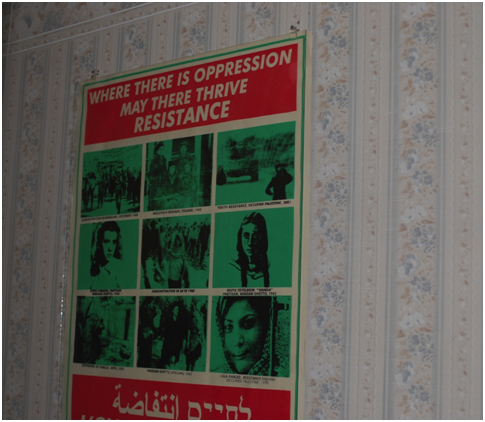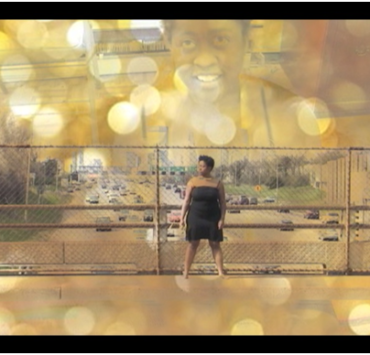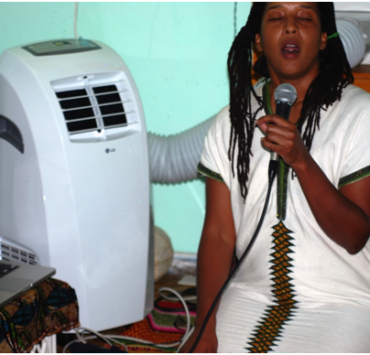
Since 2008, much art has been created behind the bedroom doors of The PoppyCock. The house itself was named for a piece of art given to me on the first night I officially (legally) slept here. It’s a vase that hangs on the wall: a beaker is set into the base of a large dildo, the shorn-off silicone head is nested between the beaker and the stretched black canvas it is mounted on, pushing the cock away from the canvas. When a flower (preferably a poppy) is put in the beaker-turned-vase, it leans forward suggestively, as if sprouting out of the dick. Artist Kelly Brazil made this in her own basement/bedroom shop, and gave it to me on the night I closed on the house. The word “poppycock” is nonsense, frivolous, sometimes scandalous and always tomfoolery. And of course, caramelized popcorn with nuts. It seemed obvious to name this home after the first piece of art to adorn its walls.
I was excited when Gabrielle and Ellen of From The Hive were inspired to create an event using The PoppyCock as stage. This space hungers for performance and creativity, so much that it almost demands it of its inhabitants. There have been many nights at home when, walking down the hall, I could hear each housemate’s music and art-making creeping out from under their bedroom door, a fussing over words or image or movement, an untethered expression emerging.
Like Gabrielle and Ellen, I’m intrigued by the line between personal and private space – as pertaining to the creative process. I see The PoppyCock as not only home and intimate dwelling and refuge, but also as shared resource; a community space. A place of gathering, where others can find themselves in it, even if they don’t live here. And what facilitates that is, specifically, art. Art helps to blur the line between public and private because of the nature of intimacy in the space, either in what is expressed or what is created. What is the creative interior, and at what point are we ready to share it, to make it public? This is illustrated when home becomes gallery or stage, for the public to witness.
I must admit that the name “Girls in Their Bedrooms” gave me pause. It was the “Girls” part that stuck, like an errant wheel veering into a ditch while the other three stayed on course. Here is why: gendered language has never been assumed or carefree at The PoppyCock. From the moment I began to live here, this house has been home to folks who don’t assume gender or take it for granted. Inhabitants here have been queerly gendered and trans-identified, or fabulously homo with a critical eye on the privilege of cis-ness. So when I took pause at “Girls”, I had to ask myself: Why? I find nothing wrong with girls, of course. There is nothing in this title that defines “girl”, or is exclusive. Furthermore, I fully trust that the curators/creators of the event are sensitive to the loaded nature of gendered language. And finally (I told myself), we should be celebrating Girls and Gurls and Grrrls in their bedrooms, creating the art we desperately need in the world. So I moved past my initial discomfort, choosing instead to embrace the challenging themes presented by the artists’ work in Girls In Their Bedrooms:
Kidnapped girls in Nigeria, missing from their beds. Overcoming our internal barriers, in order to create. The power of object and placement. The power of placing one’s self in one’s own history/origins, as an outsider. Love and being loved, loving oneself.
This is the process that art provokes, of moving through comfort and discomfort.
And intimate spaces such as homes can give it the appropriate platform to be provocative. Despite the obstacles that can arise when turning a private dwelling into public art space (such as accessibility and visibility of location, to name just two of the issues that arose in having GITB at The PoppyCock), it is a gift and an honor to be a part of, and I believe it strengthens community.

Josina Manu Maltzman writes: “I am a carpenter by day, a production manager by night, a writer by passion, and a rabble-rouser by everything else. I’ve been writing short stories and essays for as long as memory provides, with the honor of being published in That’s Revolting! Queer Strategies for Resisting Assimilation in 2004. I have had also the pleasure of working with Ananya Dance Theatre as Production Manager for the company, since January 2013. This allows me to combine my organizational and creative efforts, working with a dance company rooted in values of social, racial and environmental justice — the same values that propel me in my personal endeavors. Currently I am working on a mytho-biography spanning multiple generations of a Jewish family, which relates historical trauma to cycles of violence, both intimate and global. I was awarded a MN State Arts Board Artist’s Initiative Grant in 2014 to further this project.”







